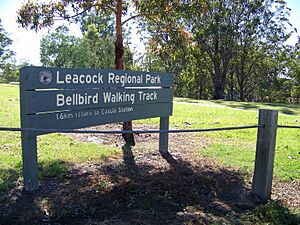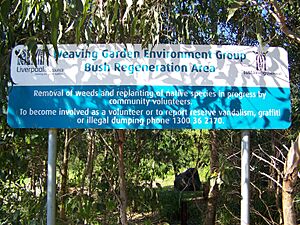Casula, New South Wales facts for kids
Quick facts for kids CasulaSydney, New South Wales |
|||||||||||||||
|---|---|---|---|---|---|---|---|---|---|---|---|---|---|---|---|

View of the Casula Powerhouse and Casula railway station from Jamison Park, Buckland Road
|
|||||||||||||||
| Population | 15,662 (2016 census) | ||||||||||||||
| Postcode(s) | 2170 | ||||||||||||||
| Elevation | 48 m (157 ft) | ||||||||||||||
| Location | 34 km (21 mi) south-west of Sydney | ||||||||||||||
| LGA(s) | City of Liverpool | ||||||||||||||
| State electorate(s) | Macquarie Fields, Holsworthy | ||||||||||||||
| Federal Division(s) | Werriwa | ||||||||||||||
|
|||||||||||||||
Casula is a suburb located in Sydney, New South Wales, Australia. It is about 34 kilometres south-west of the main city centre. Casula is part of the City of Liverpool local government area.
This suburb is just south of Liverpool. It sits along the Hume Highway and the Main Southern railway line. This railway line connects Sydney and Melbourne. Casula has gently rolling land, mostly 30 to 70 metres above sea level. The Georges River forms the eastern edge of the suburb.
Contents
Casula's Early History
Aboriginal Heritage
The first people to live in the Casula area were the Tharawal (or Dharawal) people. They are an Aboriginal Australian group. The Tharawal people belong to the larger Eora nation. "Tharawal" refers to both the land and the people. Their traditional country covers parts of southern and south-western Sydney. The superb lyrebird is the special animal, or totem, for Tharawal country.
European Settlement and Growth
European settlers, mostly farmers, arrived in Casula in the 1800s. One of the first farmers was Richard Guise. He named his farm "Casula." The area became known for poultry farming, growing vegetables, and fruit.
Another important farm was Glenfield Farm. It started around 1817. This farm belonged to Charles Throsby, an explorer and politician. Glenfield Farm is the oldest farm in Australia that has been worked continuously. It is a listed heritage site.
During World War I, a large training camp for Australian soldiers was in Casula. A street called "Reserve Road" is named after this camp. In 1916, there were some difficulties at the camp. Soldiers faced strict training rules. This led to some disturbances in nearby Liverpool.
In 1918, Walter Ingham Sr. bought land in Casula. He gave it to his son, Walter Jr. This started a small chicken breeding business. After Walter Sr. passed away, his sons Jack and Bob took over. They grew it into Inghams Enterprises, Australia's largest chicken and turkey producer. Their main office is now in Liverpool.
Casula Post Office opened in 1924 but closed in 1979. Another office, "Liverpool South," changed its name to "Cross Roads" in 1964. It became "Casula Mall" in 1990 and is still open today.
For a long time, Casula was mostly farmland. It only started to become a suburban area in the late 1950s. Many parts of Casula were developed with houses over the next few decades. However, some undeveloped land still remains.
Heritage Sites
Casula has some places that are important for their history. These are called heritage-listed sites.
- 88 Leacocks Lane: Glenfield Farm
Natural Environment
Cumberland Plain Woodland
The natural plant community in Casula is called Cumberland Plain Woodland. This type of forest once covered huge areas of south-western Sydney. It is a very important and unique ecosystem.
Leacock Regional Park
Leacock Regional Park is managed by the National Parks & Wildlife Service. It protects one of the last remaining areas of Cumberland Plain Woodland. This park is also home to the critically endangered Cumberland Plain Land Snail. This snail is very rare.
From the ridge at the top of the park, you can see the bushland of Holsworthy. There is a walking track called the "bellbird walking track." It goes through the Cumberland Plain Woodland. You can connect it to a track along the Georges River. This track leads to a lookout near the Casula Powerhouse Arts Centre. A group called 'Weaving Garden' helps to restore the bushland in the park.
Important Landmarks
The Casula Powerhouse Arts Centre (CPAC) is a well-known landmark. It is located next to Casula railway station. The building used to be a power station in the 1950s. After it was no longer used, it was fixed up and reopened in 1994. Now, it is a busy arts centre.
CPAC hosts many different exhibitions and art events. These events often show the diverse cultures of the community. Since 2016, CPAC has also hosted the Blake Prize. This is an art award that focuses on spirituality.
Shopping and Services
Casula Mall is a shopping centre in Casula. It opened in 1986 and is owned by AMP Capital. It has a Kmart department store and a Coles supermarket. There are also about forty other smaller shops.
The Crossroads Homemaker Centre is another shopping area. It is at the southern end of Casula. This centre also belongs to AMP Capital. It includes a Bunnings Warehouse for hardware. You can also find Costco, furniture stores, and electrical stores like Bing Lee and The Good Guys here.
Getting Around Casula
Casula is bordered by the M5 Motorway to the north and west. This motorway provides a fast way to get to central Sydney and the North Shore. The Hume Highway also runs through the middle of Casula.
Casula railway station is on the Main Southern railway line. However, it is a bit far from the main shopping areas. Transit Systems buses offer regular services. These buses connect Casula to the main shopping and transport hub of Liverpool. They also go to Liverpool station.
Many people in Casula also use Glenfield station. It is often easier to reach and offers faster train services into Sydney. Buses connect Casula and Glenfield along the Hume Highway.
Schools in Casula
Casula Primary School opened in 1959 on De Meyrick Avenue. Casula High School opened later, in 1973. All Saints Catholic Senior College is the only Catholic school in the suburb. It opened in 1987.
Homes in Casula
Casula is known for having a mix of different types of homes and people. The central and southern parts of the suburb mostly have privately owned houses. This includes the famous ranch-style mansion on Old Kurrajong Road. It is owned by Bob Ingham.
Population Information
The 2016 census showed that Casula had a population of 15,662 people. Most of these were families. About 73.4% of homes were separate houses. Around 24.6% were semi-detached houses, townhouses, or similar. Only 1.6% were flats or apartments.
In Casula, 51.1% of people were born in Australia. Other common countries of birth included Iraq (3.6%), Fiji (3.3%), Lebanon (2.7%), India (2.5%), and Vietnam (2.0%). About 39.9% of people spoke only English at home. Other languages spoken included Arabic (14.5%), Hindi (4.2%), Greek (2.8%), Vietnamese (2.8%), and Italian (2.5%).
For religion, the most common responses were Catholic (27.3%) and Islam (15.9%). About 9.5% said they had no religion. Christianity was the largest religious group overall, with 59.0% of the population.





